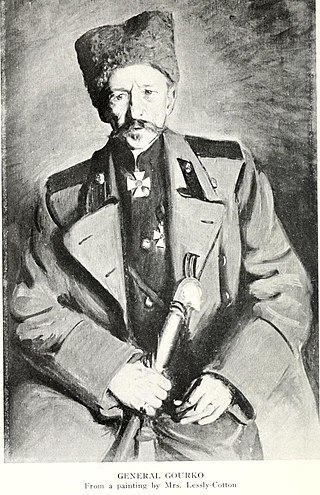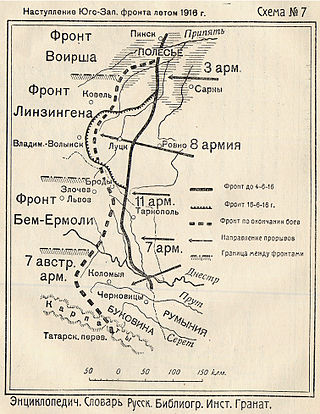Related Research Articles

The Lake Naroch offensive in 1916 was an unsuccessful Russian offensive on the Eastern Front in World War I. It was launched at the request of Marshal Joseph Joffre and intended to relieve the German pressure on French forces. Due to lack of reconnaissance, Russian artillery support failed to overcome and neutralise the well-fortified German defenses and artillery positions, leading to costly and unproductive direct attacks, hindered by the weather. On 30 March General Evert ordered a halt to the offensive.

The Russian Caucasus Army of World War I was the Russian field army that fought in the Caucasus Campaign and Persian Campaign of World War I. It was renowned for inflicting heavy casualties on the opposing forces of the Ottoman Empire, particularly at the Battle of Sarikamish. It was also known for its extremely diverse ethnic composition, consisting of units from throughout the Russian Empire and both soldiers and officers from the many ethnic communities settled since the 1877-78 Russo-Turkish War in the militarily administered Kars Oblast in the Russian Transcaucasus. These included Georgians, Caucasus Greeks, and Armenians - the latter in particular strongly represented among both the soldiers and senior officers - as well as ethnic Russians and Ukrainians.

Vasily Iosifovich Romeyko-Gurko served for a brief period as a Chief-of-Staff of the Imperial Russian Army before being forced out of the country in exile following the October Revolution of 1917.

The Russian Third Army was a World War I Russian field army that fought on the Eastern theatre of war.

The Romanian Front was an army group level command of the Imperial Russian Army and the Romanian Army during the First World War.

The Southwestern Front was an army group of the Imperial Russian Army during World War I as part of the Eastern Front war theater.
The Western Front was an army group in the armed forces of the Russian Empire during the First World War. It was established in August 1915 when the Northwestern Front was split into the Northern Front and Western Front, and was disbanded in 1918. From the time of its formation until the final year of its existence, the Western Front's field headquarters was in Smolensk, but it was later moved to Minsk.

The 10th Army was a field army of the Imperial Russian Army during the First World War.
The Russian 11th Army was a World War I Russian field army that fought on the Eastern theatre of war.

The Russian Eight Army was a World War I Russian field army that fought on the Eastern theatre of war.
The 12th Infantry Division was an infantry formation of the Russian Imperial Army that existed in various formations from the early 19th century until the end of World War I and the Russian Revolution. The division was based in Lutsk in the years leading up to 1914. It fought in World War I and was demobilized in 1918.
The 16th Infantry Division was an infantry formation of the Russian Imperial Army.
The 25th Infantry Division was an infantry formation of the Russian Imperial Army. It was a part of the 3rd Army Corps.
The 26th Infantry Division was an infantry formation of the Russian Imperial Army.
The 27th Infantry Division was an infantry formation of the Russian Imperial Army. It was a part of the 3rd Army Corps.
The 4th Cavalry Division was a cavalry formation of the Russian Imperial Army.
The 6th Army Corps was an Army corps in the Imperial Russian Army.

During the Russian Civil War of 1917-1923, a number of former Tsarist officers joined the Red Army, either voluntarily or as a result of coercion. This list includes officers of the Imperial Russian Army commissioned before 1917 who joined the Bolsheviks as commanders or as military specialists. For former Tsarist NCOs promoted under the Soviets, see Mustang.
The Southern Army was an operational–strategic formation of the White Guards troops on the Don in the summer and autumn of 1918 during the Civil War.

The 51st Lithuanian Infantry Regiment, known as the 51st Lithuanian Infantry Regiment of His Imperial Highness Heir to the Tsarevich from 1904, was an infantry regiment that served in the Imperial Russian Army.